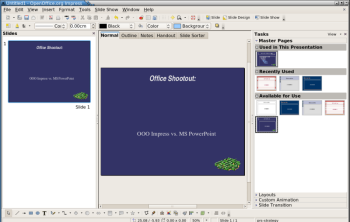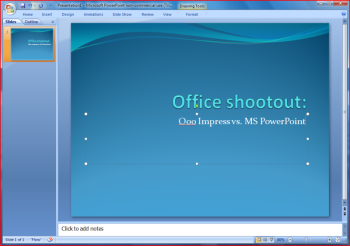Author: Bruce Byfield
How does the current version of OpenOffice.org (OOo) compare with Microsoft Office in its ability to produce slide presentations? The last time I tried to answer that question, two years ago, both OOo Impress and Microsoft PowerPoint had features that the other lacked. To see how the two programs compare now, I installed Microsoft Office 2007 and OpenOffice.org 2.3, and went through the process of designing a slide show from start to finish. To my surprise, the results were more decisive than in my last comparison. They’re not enough to award a knockout victory, but, even based on points, the winner is clear.
Starting the creation of a presentation in the Office 2007 version of PowerPoint is different in several ways from earlier versions. First, the Autosummarize feature in Microsoft Word is no longer part of the default interface, so you can no longer easily create a slide show from the outline headings in a text document. Microsoft TechNet explains that Autosummarize was removed because it was a “low use feature.” Personally, I am glad that version 2.3 of OOo Writer retains the equivalent Abstract feature.
Second, in 2007, PowerPoint no longer starts with a wizard. The removal might be justified on the grounds that, these days, everybody knows how to create a slide show. Still, Impress 2.3’s opening wizard continues to be handy way of setting up a slide show’s basic design, no matter what your level of expertise. If you don’t like the wizard, you can easily bypass it by clicking the Create button at any time.
PowerPoint 2007 also departs from earlier versions’ tradition of choosing a background at the start. Instead, it opens on a plain white slide, leaving you the option of choosing another background from the Design tab. This change might encourage users to focus more on content than design — an idea that the noticeably sedate backgrounds installed with PowerPoint seems to bear out. Inn comparison, Impress once more remains unchanged.
All these changes seem unnecessary, and would ordinarily give Impress the advantage in this category. However, one thing that hasn’t changed is that Impress continues to come with two amateurish backgrounds, while PowerPoint includes 20 backgrounds with the installation and includes a link to more online. The convenience of this selection alone is enough to give PowerPoint the edge.
Verdict: PowerPoint. You can search for more Impress templates online, but OOo could at least include a built-in link to them.
Editing window layout
Like the rest of Microsoft Office 2007, PowerPoint uses ribbons, which are combination menus and toolbars, instead of the traditional menus Impress still uses. Unlike Microsoft Word’s chaotically arranged ribbons, PowerPoint’s are well-organized, but, after five minutes’ use, on the whole, they seem neither better nor worse than Impress’s menus — only different.
Below the menus, PowerPoint’s editing window is divided into two panes: one for all the slides in the show, and another for the current slide. To this arrangement, Impress adds a Tasks pane on the right in the default view that toggles between master pages and slide layouts — elements relegated in PowerPoint to the Design ribbon and the right-click menu for slides, respectively.
What you think of Impress’s three-pane view will probably depend largely on your monitor or work habits. At full-screen resolution, or on a 19-inch or greater wide screen monitor, it is convenient, but, at any other size, or on a small monitor, the active slide is too small to edit. However, unlike in PowerPoint, the left and right panes in Impress can be detached to become floating windows that you can move as needed on the screen. Add this convenience to the tabs to change the view in the central pane, and Impress’s design makes features more accessible than PowerPoint’s.
Verdict: Impress.
Available slide layouts and transitions
Choosing slide layouts and transitions are two basic operations in presentation designs. Impress offers 20 slide layouts to PowerPoint’s nine, and although several of Impress’s are covered by one of PowerPoint’s, they are still more convenient for thinking about your selection of material.
With slide transitions, PowerPoint has a slight edge, boasting 58 to Impress’s 55. However, the real advantage of PowerPoint’s slide transitions is that they are arranged visually into categories, as opposed to Impress’s alphabetical list. In both programs, you can test slide transitions on the current slide.
Verdict: Tie.
Drawing tools,charts, and graphs
In previous releases, the fact that Impress shared a basic engine with OOo Draw gave it an advantage when it came to tools for diagrams and organizational charts. However, while Impress has remained largely the same, PowerPoint has achieved approximate equality with the Illustration and Text panes on the Insert ribbon.
Conversely, with OOo 2.3’s new charting subsystem, Impress has caught up to PowerPoint in graphs based on spreadsheet information. Both programs now give professional-looking, easily editable charts, with the only difference being the default color schemes for the graphs.
Verdict: Tie.
Tables
PowerPoint has had a table tool for at least a decade. Impress, however, still lacks one, although, like PowerPoint, it can import a spreadsheet or a text file to achieve the same effect. Alternatively, you can cobble a table together using a series of rectangles, but the point remains: Why should you have to?
Verdict: PowerPoint.
Movies and slides
When I last compared slide shows two years ago, Impress only supported .wav, .aif, and .au sound and movie formats. In the releases since then, Impress has added support for QuickTime, MIDI, MPEG, and WAVE formats, giving it a rough parity with PowerPoint, except for the continued lack of support for MP3 audio files.
However, Impress continues to lag because of its inability to control the playing of sound across a series of slides, or to record a narration directly from the program..
Verdict: PowerPoint.
Preparing slide shows
In either Impress or PowerPoint, you can rehearse timings for a finished slide show or create multiple custom shows that consist of selected slides. However, each has features that the other lacks. PowerPoint, for instance, offers a choice of resolutions at which to play a show, while Impress has options such as using the mouse as a pointer and using the OOo Navigator as an aid for jumping between separated slides.
Perhaps the most important of these unique features is PowerPoint’s Package for CD, which copies all necessary files for the presentation. Of course, it is easy enough to copy all of a presentation’s files from outside Impress, but doing so within the program is a convenience that gives PowerPoint a slight edge. Admittedly, the feature raises questions about distributing proprietary fonts, but, if the same functionality were available in Impress, you could easily sidestep such questions by using only free fonts.
Verdict: PowerPoint.
And the winner is …
Both Impress and PowerPoint are adequate for average slide show designers. Where one has an advantage in a particular category, that advantage is usually small.
However, Impress is advancing neither as far nor as fast as might be expected. Most significantly, despite some improvements, it continues to lag behind in its use of sound.
In comparison, PowerPoint starts from a more complete feature base, and, in places where it was behind Impress, such as graphics, it has largely caught up to Impress in the latest version.
Of course, if you extend your concern beyond functionality, in some ways Impress has advantages over PowerPoint. Unlike PowerPoint, its design is closer to that of other programs in its office suite. Even more importantly, it is undoubtedly the most advanced slide show program available in free software. However, unlike OOo Writer, Impress still has a ways to go before it matches its Microsoft Office counterpart.
Categories:
- Reviews
- Office Software




